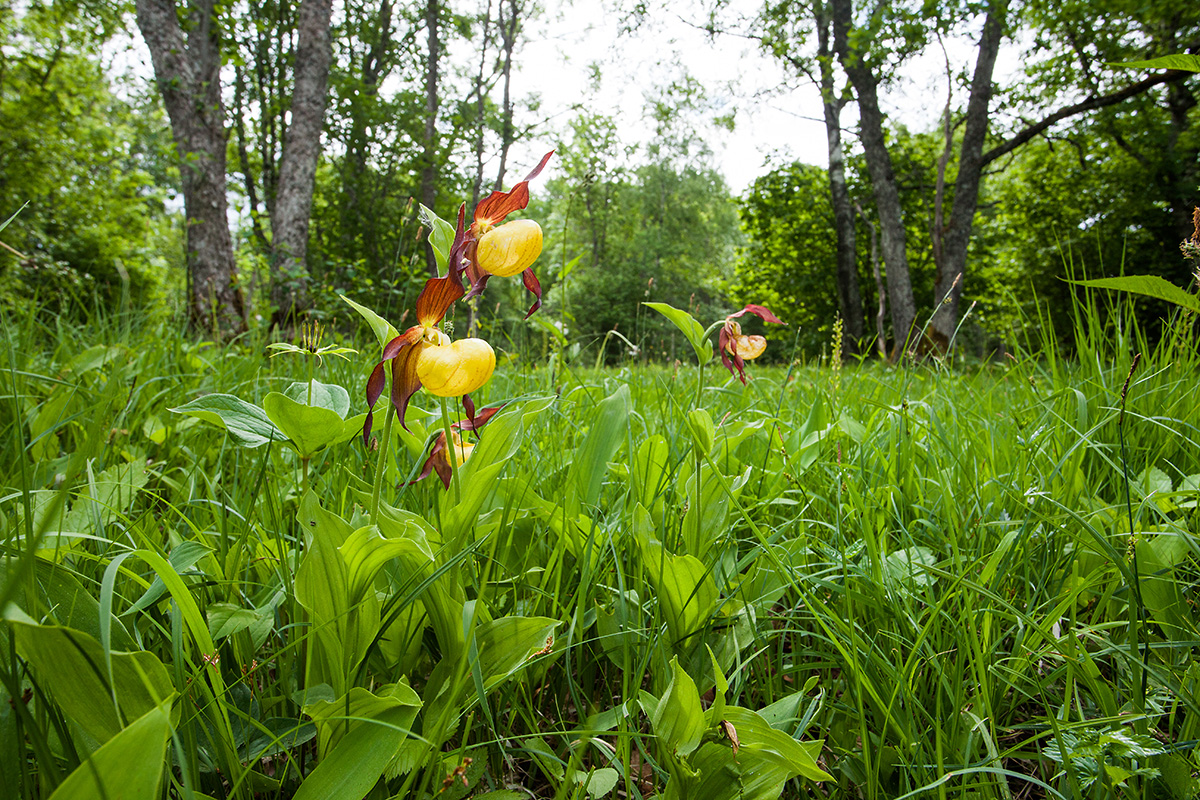Heritage meadows have been created as a result of nature-friendly management

Coastal meadow is a grassland on the sea shore that is more or less affected by saline seawater. Coastal meadows are located in flat, turfed coastal areas. As animals have historically been grazed there, they are therefore also called coastal pastures or coastal grasslands. Coastal meadows are mainly located in Western Estonia and on the islands.
A flood-meadow is a flooded grassland on the banks of rivers and lakes, created mostly as a result of the removal of floodplain forests and subsequent grazing. The nutrients found in the mud accompanying the flood water are very important for flood-meadows and help maintain a high content of nutrients in the soil. Flood-meadows are widespread in Estonia due to the dense river network. Large floodplain massifs occur along larger rivers – for example, the Emajõgi, Kasari, Pedja, Põltsamaa, Halliste rivers.
An alvar occurs on thin, up to 20-centimetre layer of calcareous soil on a limestone base. There are few trees and shrubs there, mostly junipers. Sheep are often grazed in these areas. The growing conditions in alvars are difficult – in summer, the soil can dry out and in winter, they are at the mercy of wind and cold. Nevertheless, next to the wooded meadows, alvars are some of our most species-rich communities. Alvars are mostly found on the islands and in Western and Northern Estonia.
A wooded meadow is a sparse stand that is regularly mowed, i.e. a natural grassland with scattered trees and shrubs. In order for a wooded meadow to survive, annual mowing and the curbing of woody plants is necessary. If this is not done, the wooded meadow will overgrow. Wooded meadows are some of the most species-rich communities. Wooded meadows are more widespread in Western Estonia.
A wooded pasture is very similar to the wooded meadow: it is a wooded meadow-like community, where the grass turf has been maintained for a long time due to the grazing of animals. The density of the tree layer of wooded pastures is very variable.
A dry/fresh grassland is a natural pasture and hayfield with a natural grassland flora that is dry or moderately moist. It is usually formed from a forest as a result of felling or fires. Today, most such grasslands have been turned into forests or arable land. In their typical form, they are still visible in protected areas, such as Matsalu and Viidumäe.
A paludified meadow is a wet grassland that is a transitional community between the dry grassland and the minerotrophic fen – therefore, the plants characteristic of both communities also grow there. Paludified meadows have been formed mainly from the paludification of dry grasslands or from paludified forests. Paludified meadows can be found everywhere in Estonia.
A heath is a dry, open area with individual trees, usually pines or junipers. The soil of the heaths is thin, sandy, and low in nutrients, with heather dominating the plants. The heaths are usually the result of grazing and irregular burning.
Although semi-natural communities are communities formed as a result of human influence, they are one of the most endangered habitats in Estonia. Heritage meadows were most numerous at the end of the nineteenth century, when they covered more than 1/3 of the territory of Estonia [1]. In the middle of the twentieth century, their numbers began to decline sharply due to changes in agricultural methods and the replacement of handicraft with large-scale production. Small articulated grasslands and pastures were merged into large cultivated grasslands and intensively managed fields. Fertile areas were turned into fields, less fertile and more inaccessible ones were allowed to overgrow. Over time, the latter were eventually replaced by shrubs, forests, or reed beds. Today, semi-natural communities make up about 3% of Estonian land, of which 2/3 are located in protected areas. Heritage meadows are more common in Estonia in Western Estonia and on the islands.
As a result of the overgrowth, the species richness of former semi-natural areas decreases significantly. As semi-natural communities do not survive without human assistance, they must be protected and maintained. According to the nature conservation development plan, by 2020, 45,000 ha of restored and maintained semi-natural communities should have been achieved. In reality, a few thousand were missing from the target.
In order to preserve the biodiversity of heritage meadows and to plan protection measures for this purpose, an action plan for heritage meadows for 2021–2027 has been created, which provides an overview of the current situation and risk factors, as well as describes the objectives for 2021–2027 and measures to achieve them.
In addition, heritage meadow maintenance plans have been developed in collaboration with experts and researchers. They contain important information on the conservation values of different habitat types and on maintenance and restoration techniques. The following have been compiled:
- a maintenance plan for flood-meadows;
- a maintenance plan for coastal meadows;
- a maintenance plan for alvars and juniper shrublands;
- a maintenance plan for wooded meadows and wooded pastures;
- a maintenance plan for dry/fresh grasslands and paludified meadows.
Last modified: 10.11.2021
_________________________________________________
[1] T. Kukk, M. Sammul. Loodusdirektiivi poollooduslikud kooslused ja nende pindala Eestis. Eesti Looduseuurijate Seltsi aastaraamat 84. köide. Tartu: Eesti Looduseuurijate Selts, 2006, lk 114–158.